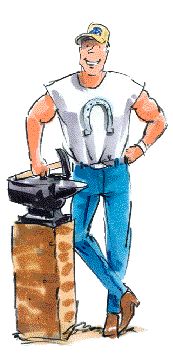 Finding the proper individual
to work with is imperative. You will want to be able to have a good working
relationship that will last for the lifetime of the horse. This means that your farrier needs to be not only knowledgeable but also able to pass on this
knowledge to you. To this end, do not take your horse to someone who is hurried,
carries on conversations with third parties, or arrives late to the appointment.
Additionally, the farrier should be well equipped for the job, and not have to
run back and forth to get more supplies, or worse yet, schedule another visit to
finish up because she or he does not have the wedges or pads needed. A good
farrier will be well equipped to also follow your veterinarian’s recommendations
if certain corrective actions are needed for the treatment of the hooves. Finding the proper individual
to work with is imperative. You will want to be able to have a good working
relationship that will last for the lifetime of the horse. This means that your farrier needs to be not only knowledgeable but also able to pass on this
knowledge to you. To this end, do not take your horse to someone who is hurried,
carries on conversations with third parties, or arrives late to the appointment.
Additionally, the farrier should be well equipped for the job, and not have to
run back and forth to get more supplies, or worse yet, schedule another visit to
finish up because she or he does not have the wedges or pads needed. A good
farrier will be well equipped to also follow your veterinarian’s recommendations
if certain corrective actions are needed for the treatment of the hooves.The beginning of the visit should entail your farrier’s taking a look as the
horse walks to ascertain if there are problems with the way the hoof makes
contact with the floor. Secondly, she or he will want to observe the horse
standing still. Prior to trimming the foot, this will permit the farrier to see
if there are any signs of imbalance that need to be corrected. While you do want
your blacksmith to use a hoof angle, you do not want her or him to completely
rely on it and disregard your horse’s individual gait. The goal is to have the
angle of the heel line up with the angle of the toe, resulting in symmetry of
the hoof which in turn will ensure that the horse will not overly stress its
legs and tendons.
When the farrier trims the sole, she or he will want to only remove the material
that is flaking off visibly. A good farrier understands that the thicker the
sole, the more protection for the inner portion of the foot is offered. She or
he will want to leave the heel bars intact, and only trim the heel up to the
wide part of the frog – the latter should not be trimmed or only as little as
possible.
As you can see, there is a lot more to shoeing your horse than meets the eye. To
this end, get recommendations for farriers from the American Farriers
Association which will be able to point you to certified journeymen who should
be the only people you permit to do hot shoeing!
 |